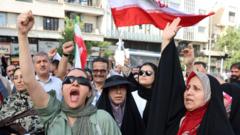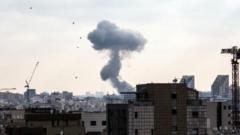On June 22, 2025, Pentagon officials disclosed a critical military strike against Iran's nuclear infrastructure, emphasizing severe damage inflicted on facilities at Fordo, Natanz, and Isfahan. The operation, initiated from Missouri, involved stealth bombers and submarine-launched missiles, showcasing U.S. military prowess while leaving the ultimate impact on Iran’s nuclear capabilities uncertain.
U.S. Military Launches High-Stakes Operation Against Iranian Nuclear Facilities

U.S. Military Launches High-Stakes Operation Against Iranian Nuclear Facilities
The Pentagon unveiled a secretive military operation, "Operation Midnight Hammer," targeting three key Iranian nuclear sites with advanced air and sea capabilities.
In a stunning display of military capabilities, senior Pentagon officials disclosed on Sunday the details of a meticulously coordinated operation against Iran, signifying a pivotal moment in U.S. defense strategy. Dubbed "Operation Midnight Hammer," the mission struck critical Iranian nuclear facilities during a highly classified initiative that involved multiple military branches working in unison.
Defense Secretary Pete Hegseth and Gen. Dan Caine, chairman of the Joint Chiefs of Staff, addressed reporters at the Pentagon, revealing that the offensive had targeted significant nuclear locations: Fordo, Natanz, and Isfahan. The operation was executed with precision in a narrow time frame of just 25 minutes.
Hegseth reiterated President Trump's earlier statement, claiming that the Iranian sites had been "obliterated." However, he and Caine stopped short of confirming whether Iran had completely lost its capability to develop nuclear weapons. The final assessment of the damage will take time, according to Gen. Caine, though initial reports suggested that all three facilities experienced extensive ruin.
The B-2 stealth bombers, which took off in secrecy from Whiteman Air Force Base in Missouri, undertook a perilous journey of over 7,000 miles across the Atlantic and Mediterranean, demonstrating the reach of U.S. military power. They carried out precision strikes against the fortified sites under the cover of darkness, marking a significant escalation in regional tensions.
The Pentagon’s presentation of this operation underscores a bold shift in military tactics, utilizing innovative technologies and collaborative efforts between air and naval forces to neutralize perceived threats. As analysts ponder the long-term implications of this strike, one question remains: How will Iran respond, and what does this mean for future U.S.-Iran relations?























